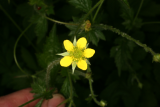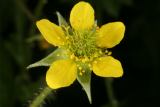Additional notes (click to expand)
Medicinal
Culpeper: ‘...the roots ... keep garments from being moth eaten. See the leaves.’ Under leaves he writes: ‘... they help the cholich, rawness of the stomach, stitches in the side, stoppings of the liver, and bruises.’
Culpeper, Nicholas. (1650). A Physical Directory . London, Peter Cole.
Nomenclature
Cariophillatae: of Avens or Herb Bennet.
Culpeper, Nicholas. (1650). A Physical Directory . London, Peter Cole.
CLOVEROOT; WOOD AVENS.
Other use
While it is still used in herbal medicine, one recipe involves macerating it for a fortnight in proof spirit (40% w/v) and one wonders if the equivalent of neat whisky might not have had the therapeutic effect.
Oakeley, Dr. H. F. (2013). The Gardens of the Pharmacopoeia Londinensis.
It has a long history of early Christian associations, and was known as the ‘Blessed Herb’, in Latin Herba benedicta, and hence to St. Benedict’s Herb, as this saint was supposed to have blessed a glass of poisoned wine whereupon the glass broke. Quite how the latter related to the plant is not clear, but 15th century monks believed that it protected one against poisons and hanging it around one’s neck kept Satan at bay.
Oakeley, Dr. H. F. (2013). The Gardens of the Pharmacopoeia Londinensis.
Geographical distribution
- Africa, Northern Africa
- Asia-Temperate, Caucasus
- Asia-Temperate, Middle Asia
- Asia-Temperate, Siberia
- Asia-Temperate, Western Asia, Iran
- Asia-Temperate, Western Asia, Iraq
- Asia-Temperate, Western Asia, Turkey
- Europe, Eastern Europe
- Europe, Middle Europe
- Europe, Northern Europe
- Europe, Northern Europe, Great Britain
- Europe, Northern Europe, Ireland
- Europe, Southeastern Europe
- Europe, Southwestern Europe
Geum urbanum L.
Family: ROSACEAEGenus: Geum
Species: urbanum L.
Common names: Herb Bennet; Blessed Herb
Pharmacopoeia Londinensis name: Caryophyllata
Distribution summary: Europe to Himalaya
Habit: Perennial
Hardiness: H4 - Hardy; average winter
Habitat: Deciduous woods, scrub, hedgerows, calcareous woods
Garden status: Currently grown
Garden location: Pharmacopoeia Londinensis 1618 'Roots' (HSE 3)
Flowering months: June, July, August
Reason for growing: Medicinal




